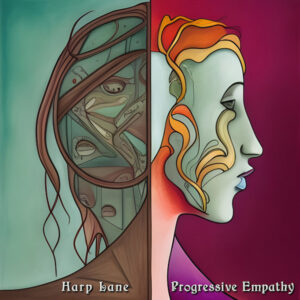There seems to be an abundance of creative, original music being written for harp. Here are two of these new publications in different genres.

Juan Maria Solare has written a lovely new collection of five solos for harp called Progressive Empathy. In the liner notes, Solare painstakingly describes his motivation and how the five pieces are interrelated. He writes, “In this cycle of pieces, I follow a title scheme that has been appealing to me lately: getting the titles of the individual pieces, read together, to form a short poem (or at least a sentence with some meaning).” The image he is trying to convey with these titles is “a pond listening attentively to a snowflake, but not just to one, but to many—countless, consecutively, and with infinite patience—until tempers subside and clarity returns.”
If this explanation seems a little esoteric, don’t worry. Solare further clarifies that each title alludes to an English idiomatic expression that is briefly defined at the beginning of each score. After reading all the idiom definitions, you may have a better understanding of the concepts he was trying to tie together. Regardless, these are five pretty pieces that can be played separately or collectively with equal appeal. If you play them all, it takes about 12 minutes.
The first piece is “Millpond,” a somewhat pensive melody in G major. Solare tells us “to be as calm as a millpond” is an English idiom, and the music does indeed have a calming quality. It features mostly a single-note melody and fairly simple, arpeggiated left hand. There is an accidental marking in m. 32 for C-natural that isn’t necessary. The composer suggests that you can eliminate m. 37 if desired, as it requires a B- and E-flat. However, it is an easy pedal change that is also manageable on lever harp, and it adds some appealing harmony. The composer shared that this piece was selected by the Association of Harp Players in Germany in their latest composition competition.
Next is “Lending an Ear,” depicting an English idiom that means “to listen attentively and sympathetically to someone revealing their troubles.” It is in B minor. The left hand accompaniment is similar to the previous piece but with the addition of a repeated, pulsing bass note towards the end that ultimately ends the piece.
“To be as quiet as a snowflake” is the English idiom on which the third solo, “To a Snowflake,” is based. It is in A major. With a recurring D-sharp and one A-sharp, it is the most chromatic of the collection. These are not difficult on pedal harp, but a little challenging, albeit doable—if you substitute a B-flat for the A-sharp—on lever harp. A section of harmonics in the right hand adds to the delicate feel of the music.
“One After Another” is in 3/4, unlike the other pieces which are all in 4/4. This idiom is defined as meaning “consecutively and in quick succession.” It is in C-sharp minor so it can still be played on a lever harp tuned to E-flat. A few harmonics add interest.
The final selection is “Until the Dust Settles” in E-flat major. This idiom is described as meaning that things return to normal after a hectic period, a high level of activity, an argument, or a big change. There are two pedal changes of D-flat. C-sharp can be substituted on lever harp.
Each piece is no more than two pages long. There are no pedal or lever markings, or any fingering. The music is sight-readable for the intermediate player and the typesetting is easy to read. You can listen to all the music on several different platforms (e.g. Spotify) and the sheet music can be downloaded from Sheet Music Plus. If the imagery Solare was trying to evoke isn’t clear, you will nevertheless enjoy these beautiful melodies.
Those who do school programs for young children or storytelling sessions at libraries or other events might find a new publication from Afghan Press useful.

Sharon Thormahlen has written 13 tunes to accompany a fanciful tale written by her daughter, Rosiee Thor. “Valley of the Dragon” tells the story of a dragon that awakens from a century of sleep and wreaks havoc on an imaginary kingdom. A harpist overcomes the dragon with a song, and the dragon returns to a peaceful slumber. Each tune is meant to accompany a segment of the story.
The music is fairly simple, and most of it is sight-readable by lower intermediate players. Most tunes have a single-note melody line with some thirds and sixths mixed in. Chord symbols are provided throughout the book for those who want to embellish the arrangements. The only special effects are some scale glisses in “Shamrock, Amber, and Ivory,” and “A Glint of Yellow Light.”
Fingering is suggested in a few places, but only occasionally when it is helpful. The typesetting is large and easy to read, and the print version is spiral-bound to lie flat on a music stand. There are only a few page turns and they are very manageable. The tunes are suitable for lever harps tuned to E-flat.
“The Cloudy Sky Has Opened” and “With a Song, Not a Sword” are to be played in a swing rhythm. There is one lever change in the title piece, and it is indicated by a diamond-shaped note. There are some pre-set accidentals on “The Dragon Wakes” and “The Dragon’s Tail.” Pedal harpists would have to move a few pedals, and those changes are not notated.
Digital mp3s are available for purchase directly from Thormahlen. There are three versions of the story at the back of the book: a shortened version, the full story, and a more detailed prologue. The composer gives her permission to play the tunes and tell the story in whatever length is appropriate. It might be fun to enchant an audience with this fairy tale accompanied by music! •







